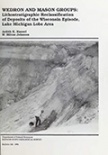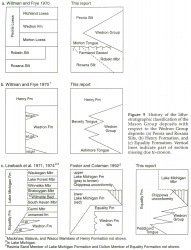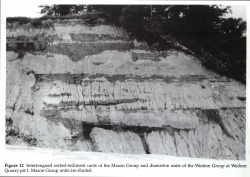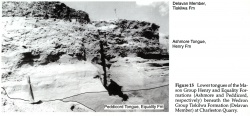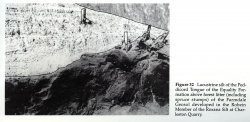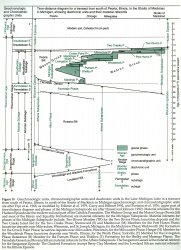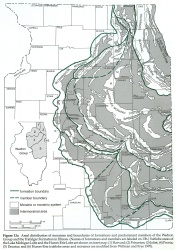Historical:Peddicord Tongue
Lithostratigraphy: Mason Group >>Equality Formation >>Peddicord Tongue
Chronostratigraphy: Cenozoic Erathem >>Quaternary System >>Pleistocene Series
Authors
Ardith K. Hansel and W. Hilton Johnson
Name
Original description
Peddicord Formation (Willman et al. 1971).
Derivation
Peddicord School in La Salle County, northeastern Illinois.
History/background
Fine grained, laminated sediment below the pink Tiskilwa till of the Bloomington Morainic System occurs at many places along the Illinois Valley between LaSalle and Morris (Willman et al. 1971). The laminated sediment, which commonly consists of thin silty clay beds separated by thin laminae of coarse silt or sand, was referred to as the "Kickapoo beds" (Sauer 1916) and later as the "Lake Kickapoo deposits" (Willman and Payne 1942). The lacustrine sediment was included in the Shelbyville drift and interpreted to have formed in the Ticona Valley after the valley was dammed at Peoria during and after formation of the Shelbyville Moraine (Willman and Payne 1942). Restudy of stratigraphic relationships at the Wedron Section by Leonard and Frye (1960), however, showed a gray till, which Willman and Frye later (1970) correlated to the Lee Center Till Member (formerly Shelbyville drift), beneath the pink till of the Tiskilwa Till Member (formerly Bloomington drift). Beneath the gray till, Willman and Frye (1970) described 6 meters (20 ft) of massive to indistinctly bedded, pink clayey silt overlying 7.6 meters (25 ft) of massive blue gray to tan silt. Both the pink and the gray silts locally contain wood fragments, and the gray silt contains molluscan fauna. The radiocarbon ages for wood from the pink and gray silt beds at Wedron (24,000 and 26,800 years before present, respectively) led Willman and Frye (1970) to classify the silt beds with the Robein Silt (Farmdalian Substage). Because of the lithologic similarity and common age of the silt beds at Wedron with those at the Morris North Section, and the dissimilarity of the silt beds at the two sections with the more massive organic rich, often peaty, Robein Silt, Willman et al. (1971) later established a new formation (named Peddicord) for fine grained, generally laminated, sediment that occurs stratigraphically beneath the basal gray Woodfordian till (Lee Center Member, Wedron Formation) and above the Robein Silt. Willman et al. (1971) attributed the Peddicord Formation to deposition in a lake that formed in the buried Ticona Valley during late Altonian and early Farmdalian time. They suggested this Lake Peddicord might have formed in response to the damming of the Ticona Valley by Altonian drift to the west. Willman et al. (1971) believed that the Peddicord Formation was older than the "Lake Kickapoo deposits," but they recognized that some of the latter deposits may have been misclassified and actually belong to the Peddicord Formation.
In the early 1980s, new excavations and interpretations in pit 1 at the Wedron Section (Johnson et al. 1985a) indicated the soil below the Peddicord Formation was the Farmdale Soil rather than the Sangamon Soil and the basal gray till of the Wedron Formation was not correlative with the Lee Center Till Member, now attributed to the Illinois Episode (Berg et al. 1985). The basal gray till was interpreted instead to have been deposited during the advance of the Tiskilwa ice to the Bloomington Morainic System. As a result of these new interpretations, Johnson et al. (1985a) classified the Peddicord Formation with the Woodfordian Substage. They broadened the concept of the Peddicord Formation to include the overlying well sorted, coarse to fine sand containing gravel beds that are up to 6 meters (20 ft) thick at Wedron. The sand was interpreted to be proglacial fluvial sediment that overlies the alluvial and lacustrine silt beds. Both the silt and sand facies were included in the lower glacigenic sequence (Johnson and Hansel 1990) at Wedron; the proglacial depositional environment was interpreted to have changed from alluvial to glaciolacustrine to glaciofluvial as the Tiskilwa ice margin advanced in northern Illinois and the drainage system in the Ticona Valley was dammed by the ice margin or by outwash from that event.
In this report the Peddicord Formation is decreased in rank to the Peddicord Tongue of the Equality Formation (fig. 9c). The Peddicord Tongue consists of fine grained laminated sediment that extends beneath the undivided Tiskilwa Formation, the Delavan Member (Tiskilwa Formation), or the Ashmore Tongue (Henry Formation). The concept of the Peddicord Tongue is extended to include other laminated sand, silt, and clay at this same stratigraphic position elsewhere in Illinois; thus, the Peddicord deposits are no longer confined to the Ticona Valley. The sand facies of the Peddicord Formation at Wedron, as modified by Johnson et al. (1985), is classified with the Ashmore Tongue of the Henry Formation.
Type section
Wedron Section (fig. 12), Wedron Silica Company quarries at Wedron, Illinois; good for contacts and lithology.
Reference section
Charleston Section (figs. 15, 32), Charleston Stone Quarry pits; good for boundaries and lithology.
Stratigraphic relationships
The Peddicord Tongue is the stratified silt and clay of the Equality Formation that extends beneath the basal red gray diamicton unit of the Tiskilwa Formation or gray diamicton unit of the Delavan Member of the Tiskilwa Formation. In places it is interfingered with other units of the Mason Group, for example, the Ashmore Tongue (Henry Formation) or the Morton Tongue (Peoria Silt).
The laminated Peddicord Tongue is generally readily distinguishable from the nonbedded silt of the Morton Tongue and the more organic, leached, stratified silt of the Robein Member. The contact of the Peddicord Tongue with the coarser grained Ashmore Tongue is sometimes gradational and/or interfingered. The Peddicord Tongue generally shows some evidence of bedding, whereas diamicton of the Tiskilwa Formation is more massive in appearance, although each unit can contain lenses of sediment similar to that of the other.
Extent and thickness
The Peddicord Tongue is a discontinuous subsurface unit found in some low-lying parts (e. g., valleys and basins) of the pre-Michigan Subepisode landscape beneath the Ashmore Member and/or the Tiskilwa Formation. It can potentially occur wherever the Tiskilwa Formation is mapped in the Harvard, Princeton, Peoria, and Decatur Sublobe areas of Illinois. The Peddicord Tongue is up to about 10 meters (33 ft) thick.
Lithology
The Peddicord Tongue consists of tongues and lentils of fine textured stratified sediment, predominantly silt and clay, that are overlain by diamicton of the Tiskilwa Formation or the Morton (Peoria Silt) or Ashmore (Henry Formation) Tongues. Detrital organic matter and in situ wood are sometimes found within the stratified sediment. The clay-mineral, pebble, and carbonate compositions of the Peddicord Tongue are similar to those of the Tiskilwa Formation diamicton.
Contacts
Lower boundary: the contact with the Morton (Peoria Silt) or Ashmore (Henry Formation) Tongues, the Robein (Roxana Silt) Member, or older units. Upper boundary: the contact with the Ashmore or Morton Tongues, the Delavan Member, or undivided Tiskilwa Formation.
Age and correlation
The Peddicord Tongue was deposited as the Tiskilwa ice margin advanced to its maximum position first in the Harvard Sublobe area (Marengo Moraine) and later in the Princeton, Peoria, and Decatur Sublobe areas (outer moraines of the Bloomington and Shelbyville Morainic Systems) between about 26,000 and 19,500 radiocarbon years ago (figs. 10, 13). It correlates with equivalent Equality Formation beyond the outer margin of the Wedron Group boundary, the lower, fine grained stratified part of the Tiskilwa Member of the Zenda Formation in Wisconsin (Mickelson et al. 1984), and part of the Atherton Formation in Indiana (Wayne 1963).
|
Environments of deposition
The Peddicord Tongue is the basal low-energy lacustrine facies of a glacigenic sequence that contains Tiskilwa Formation. The proglacial sequence might, for example, include a coarsening-upward succession consisting of loess (Morton Tongue), lacustrine clay and silt (Peddicord Tongue), and near shore and fluvial sand and gravel (Ashmore Tongue) that is overlain by ice-marginal redeposited sediment and till of the Tiskilwa Formation.
Remarks
Revised unit. Formation lowered in rank and redefined as the Peddircord Tongue of the Equality Formation.
References
BERG, R. C., J. P KEMPTON, L. R. FOLLMER, and D. P. McKENNA, 1985, Illinoian and Wisconsinan Stratigraphy and Environments in Northern Illinois— The Altonian Revised: Illinois State Geological Survey Guidebook 19, 177 p.
JOHNSON, W. H., and A. K. HANSEL, 1990, Multiple Wisconsinan glacigenic sequences at Wedron, Illinois: Journal of Sedimentary Petrology, v. 60, no. 1, p. 26-41.
JOHNSON, W. H., A. K. HANSEL, B. J. SOCHA, and L. R. FOLLMER, 1985a, The Wedron Section, Stop 1, in W. H. Johnson, A. K. Hansel, B. J. Socha, and J. M. Masters, Depositional Environments and Correlation Problems of the Wedron Formation (Wisconsinan) in Northeastern Illinois: Illinois State Geological Survey Guidebook 16, p. 13-42.
LEONARD, A. B., and J. C. FRYE, 1960, Wisconsinan Molluscan Faunas of the Illinois Valley Region: Illinois State Geological Survey Circular 304, 32 p.
MICKELSON, D. M., L. CLAYTON, R. W. BAKER, W. H. MODE, and A. F. SCHNEIDER, 1984, Pleistocene Stratigraphic Units of Wisconsin: Wisconsin Geological and Natural History Survey Miscellaneous Paper 84-1, 107 p.
SAUER, C. O., 1916, Geography of the Upper Illinois Valley and History of Development: Illinois State Geological Survey Bulletin 27, 208 p.
WAYNE, W. J., 1963, Pleistocene Formations of Indiana: Indiana Geological Survey Bulletin 25, 85 p.
WILLMAN H. B., and J. C. FRYE, 1970, Pleistocene Stratigraphy of Illinois: Illinois State Geological Survey Bulletin 94, 204 p.
WILLMAN, H. B., A. B. LEONARD, and J. C. FRYE, 1971, Farmdalian Lake Deposits and Faunas in Northern Illinois: Illinois State Geological Survey Circular 467, 12 p.
WILLMAN, H. B., and J. N. PAYNE, 1942, Geology and Mineral Resources of the Marseilles, Ottawa, and Streator Quadrangles: Illinois State Geological Survey Bulletin 66, 388 p.
ISGS Codes
| Stratigraphic Code | Geo Unit Designation |
|---|---|
